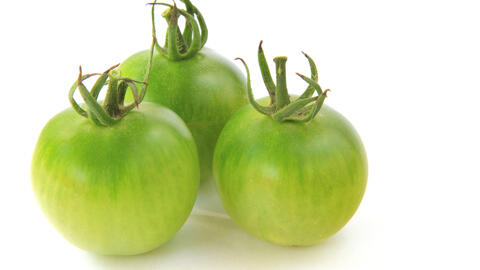Green Tomatoes: Edible Or Poisonous?
You should not eat green tomatoes as they contain the poisonous alkaloid solanine - that’s common knowledge. However, in some regions they are considered a delicacy. You can read about how poisonous green tomatoes really are here.

Unripe tomatoes contain the poisonous alkaloid solanine that the plant uses as a defense against predators
Green tomatoes are poisonous and may only be harvested when they are fully ripe and have turned completely red - that’s the rule among gardeners. But it’s not just since the film ‘Fried Green Tomatoes at the Whistle Stop Café’ by Jon Avnet appeared in cinemas in 1991 that people have been wondering whether green tomatoes are actually edible. In some regions, for example, pickled green tomatoes or jams made from green tomatoes are even considered a delicacy. We can advise you about how much poison is actually contained in green tomatoes and what effect it can have if you eat it.
If the plant world is all about protecting itself against predators, fruit-baring plants in particular make special arrangements. For tomatoes, this means camouflage and a chemical cocktail. Unripe fruit is green and therefore difficult to recognize between the plant leaves. It is only when the fruit and the seeds it contains are ripe enough to be able ensure the tomato’s procreation that they turn red or yellow, depending on the variety. All sorts of things also happen inside the fruit during the ripening process. Green tomatoes contain the poisonous alkaloid solanine. This ensures a deterring, bitter flavor and if, despite the taste, the unripe fruit is eaten in large amounts, the symptoms of poisoning soon begin to show.

Solanine is an alkaloid. This chemical group includes several thousand active substances that are generally contained in plants as defense substances. These include, for example, colhicine from meadow saffron and strychnine from nux vomica, which are fatal even in small doses. Moreover, capsaicine, which is responsible for the hot flavor in chilis and red peppers or morphine from opium poppies, which is used to treat pain, also belong to this group. Many of these substances are used in medicine in minute doses. They generally become dangerous if the plant parts that contain the substances are ingested in large amounts or consumed in another way.

As only the green parts of tomato plants contain alkaloid, the risk of poisoning only comes from consuming these parts. The first signs of serious poisoning such as dizziness, difficulty breathing, stomach pains or diarrhea occur in adults if they consume around 0.0071 ounces of solanine. If a larger amount is consumed, the central nervous system will also be damaged, leading to cramps and signs of paralysis. A dose of around 0.014 ounces is considered lethal.
Green tomatoes contain around 0.00032 to 0.0011 ounces per 3.53 ounces. So in the case of the highest concentration of the alkaloid, you would have to ingest 22.05 ounces of unripe tomatoes raw in order to cause the first signs of serious poisoning. However, as solanine has a very bitter taste, it is highly unlikely that you could ingest such an amount unintentionally.
Semi-ripe tomatoes, that is tomatoes that are very nearly ripe, only contain 0.0007 ounces of solanine per 3.53 ounces of tomato. So you would need to eat 220.46 pounds of tomatoes for it to be dangerous.
When tomatoes are fully ripe they only contain up to 0.000025 ounces per 3.53 ounces, which would mean that you would need to ingest around 63.93 pounds of raw tomatoes to be in danger of perceptible poisoning.
Overall, due to the bitter taste and the comparatively low concentration in semi-ripe tomatoes, it is relatively unlikely that you could unintentionally poison yourself with solanine. However, in some regions, green tomatoes are pickled or used to make jam. These products should be enjoyed with care, as solanine is heat-resistant and the bitter taste is disguised by sugar, vinegar, and spices. With pickled tomatoes in particular, it is assumed that up to 90 percent of the solanine content is still present and ingesting just 3.53 to 5.29 ounces can lead to symptoms of poisoning.

As soon as tomatoes have become fully ripe, they are not only no longer poisonous, they are also extremely healthy. They contain lots of potassium, vitamin C, and folate and are also extremely low in calories (only about 17 kilo calories per 3.53 ounces). However, the lycopene content - which also gives ripe tomatoes their intensive red color - is particularly interesting. This is a carotinoide and captures free radicals. It is therefore attributed with reducing the risk of cardio-vascular diseases, prostate cancer, diabetes mellitus, osteoporosis and infertility. According to a study, daily consumption of 0.00025 ounces can improve the endothelial dysfunction (dysfunction of the lymphatic and blood vessels) in cardio-vascular patients.
Even if you only harvest and consume standard red or yellow fruit tomatoes when they are fully ripe, you don’t have to avoid green tomatoes altogether - even if it is only to add some color to a dish. There are now several green fruit breeds available in trade stores, for example the yellow-green striped ‘Green Zebra’, ‘Limetto’ or ‘Green Grape’. These are not only identified by their green outer skin, but they also have green fruit flesh and are completely harmless. Tip: You can recognize when it’s time to hargest green tomato varieties as they fruit gives slightly under pressure.



